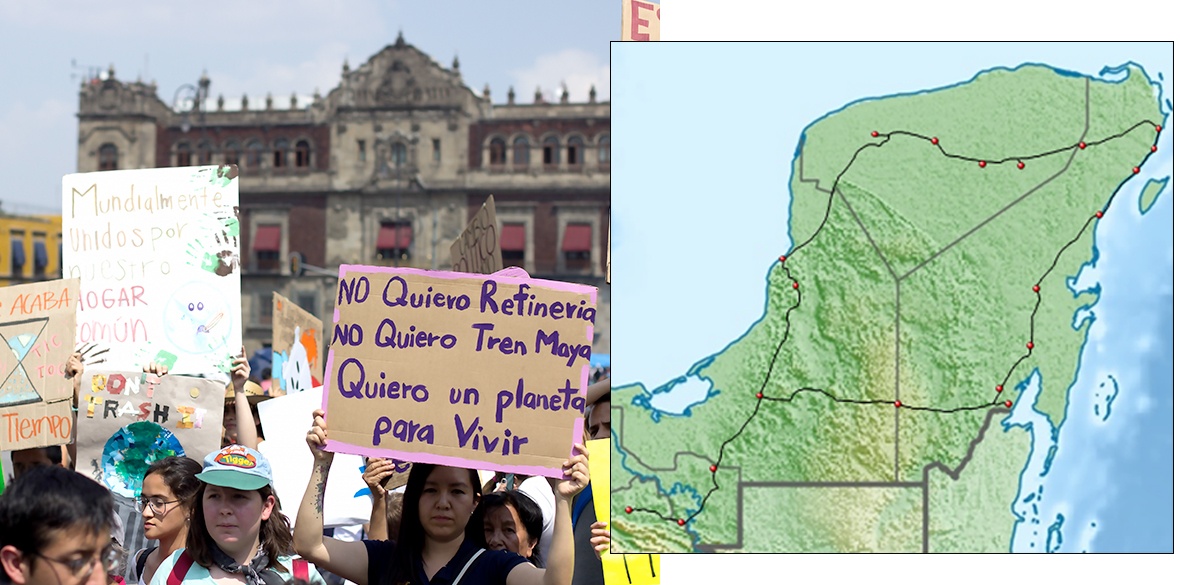This is the last article you can read this month
You can read more article this month
You can read more articles this month
Sorry your limit is up for this month
Reset on:
Please help support the Morning Star by subscribing here
THE Mayan Train is President Andres Manuel Lopez Obrador’s biggest infrastructure project, with a 1,550km route looping round the Yucatan peninsula in Mexico’s neglected south-east.
Amlo claims that it is the greatest railway project currently being built anywhere in the world.
Planned early in Amlo’s term, it is being built in seven sections, each contracted to consortia of public and private enterprises (Mexican, European and Asian) with supervision by the federal tourist agency and the armed forces.
Locomotives and rolling stock are being manufactured by Alstom of France at its existing Mexican plant in Ciudad Sahagun, Hidalgo, and when complete in December 2023 the railway will be a public enterprise.
The Tren Maya will provide an alternative to road and air transport in a region with a massive tourist industry centred in Cancun and the “Mayan Riviera,” great natural beauty and a wealth of Mayan archaeological sites and surviving indigenous cultures.
The chorus of condemnation from opponents was overwhelming. The Zapatistas (EZLN) declared that “the capitalist hydra … with this mega-project the beast will swallow in one mouthful entire villages, mountains and valleys, rivers and lakes, men, women, boys and girls.”
Where the Zapatistas led, much of the anti-globalisation, environmentalist and anarchist left followed, with NGOs in tow.
In July 2020 researchers from 65 Mexican and 26 international institutions signed “Observations on the Environmental Impact Assessment of the Mayan Train,” claiming it would cause “serious and irreversible harm.”
A highly regarded intellectual, Luis Hernandez Navarro, wrote in March 2020 that the Mayan Train was a manifestation of “savage capitalism” which robs native people of land, exploits migrant and native labour, allows genetically modified soya and hothouse crops with use of toxic chemicals and facilitates drug-trafficking and criminality.
But careful examination shows that these allegations are almost entirely false: that it is a “high-speed train” for big business. The French TGV and similar trains in Europe, Japan and China attain speeds of 320 km/hour; the Tren Maya has a maximum speed of about half that.
There will be some express services, but most will be tourist trains with stations every 60 to 80km, and quite a few will be stopping trains with subsidised fares for local inhabitants.
The railway will have 20 stations and another 14 paraderos — which we would call local stations — for a total of 34 stations.
That it will destroy the environment. It’s true that the much of the Yucatan is a low-lying limestone platform which easily develops sinkholes called cenotes.
But this did not prevent the ancient Maya from building large pyramids and cities, or the Spanish from building colonial cities (not to mention the modern monstrosities of Cancun and Playa del Carmen).
That it will destroy agricultural communities: these were mostly destroyed long ago, and those ejidos which do exist on the route are mostly commercial enterprises settled by outsiders.
They have their rights, but the few that have been expropriated have been well compensated. Much of the route follows the line of a former railway begun in the late 1930s by the great reforming president Lazaro Cardenas, which operated successfully for a few decades before being abandoned: this part of the route is already public property.
That it will violate indigenous cultures and communities: again, most indigenous communities were struggling to survive in the face of uncontrolled neoliberal development.
The Zapatista groups have their stronghold in the Chiapas highlands, around 80 to 150km from the nearest part of the railway.
That the railway will favour illegal logging, narcotics and human-trafficking of migrants: on the contrary, for the first time in decades it will provide alternative productive activities for young people.
The best answer to these ill-informed allegations comes from a 2020 article by a female Yucatecan anthropologist: “…the ancestral territories were lost centuries ago, [the farming communities] produce less and less due to the droughts of recent years, they find themselves obliged to migrate to the tourist areas or elsewhere to find work … We find forests devastated by clandestine logging and poachers who even start fires to drive out the game … highways where heavy lorries travel at great speed and run down animals … The local inhabitants are clear about one thing: paradise hasn’t existed for many years, and we cannot go on doing nothing about the situation. If transformation is what the government is offering, then that’s what has to be our hope…”
Most of the railway’s critics live in central Mexico, the US or Europe, and nine of the NGOs most active in opposition have received US funds.
Many of these same critics said nothing when enormous destruction was taking place to develop Cancun and neighbouring resorts.
Construction has already created more than 100,000 jobs, mostly skilled and well paid, and there will be tens of thousands of permanent jobs on the railway or in related activities when it is complete. Restaurant cars on the trains and local restaurants at the stations will offer traditional Mayan cuisine.
Commercial concessions at the stations will be given by preference to small local businesses selling local produce and handicrafts.
The railway will provide an environmentally friendly alternative to road and air transport, and will include freight trains.
The project includes extensive reforestation and under- and overpasses for local fauna. Construction has been accompanied by extensive archaeological research, indeed the greatest such research into the ancient Mayan cultures ever, with restoration of numerous sites, new museums and tastefully designed hotels for tourists to visit these monuments rather than just staying at beach resorts.
All of these facilities have been designed following careful consultation with local communities. Amlo and members of his cabinet, and personnel from several federal agencies constantly visit the area and almost always get an enthusiastic welcome from local inhabitants, who see this as the best thing that has ever happened to the region.
David Raby is an author and academic writing on Latin America. He can be reached at [email protected] and Twitter @DLRaby.









